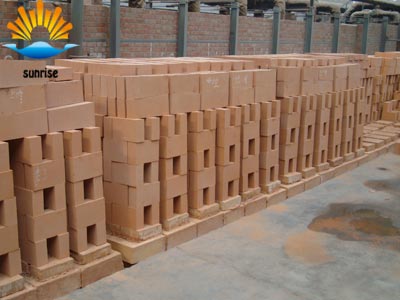Product
Fused Cast AZS Block
AZS Casting Type
AZS Ramming Materials
Fused Cast AZS TY-AZS41
Fused Cast AZS TY-AZS36
Fused Cast AZS TY-AZS33
Fused Cast Alumina Block
Fused cast Alumina Block TY-H
Fused cast Alumina Block TY-A
Fused cast Alumina Block TY-M
Fused Cast High Zirconia Block
Fused Cast Skid Rail Block
Silica brick
Magnesia Series Brick
Bonded Refractory Block
High alumina And Fire clay bricks
Insulation Series Brick
Ceramic Fiber Products
Contact Details
- 0086 371 63838939
- 0086 371 63835539
- sales@sunriserefr.com
- tkfanyi
- No.36 Fengchan Road, Zhengzhou City
Solutions
Classification and Introduction of Insulation Materials
- More related products
- Fused Cast AZS Block
- Fused Cast Alumina Block
- Fused Cast High Zirconia Block
- Fused Cast Skid Rail Block
This material is small, porosity, thermal conductivity of small materials is commonly referred to as the insulation material, according to the requirements of thermal insulation material thermal conductivity of less than 0.23 W / (m · ℃), the porosity is generally more than 70% (Usually less than 0.5 g / c rr13), mechanical strength is low, these are the common characteristics of various insulation materials.
Many kinds of insulation materials, according to the use of different temperatures can be divided into high temperature (1200 ℃ above) insulation materials, the temperature (900 ~ 1100 ℃) insulation materials, low temperature (900 ℃ below) three categories of insulation materials.
1 high temperature insulation material


Light clay brick, lightweight alumina brick, lightweight silica brick, alumina refractory hollow ball, all kinds of refractory fiber products are all high temperature insulation materials.
2 medium temperature insulation materials
2.1 ultra-light perlite products
Ultra-lightweight perlite products are made of natural rock after calcination, the volume greatly expanded, the resulting density is very small (can be as small as 60 kg / rr13) of the senior insulation material, this material can be used as a powder (filling In the stove between the masonry and the shell), but the majority of adding water glass, cement or phosphoric acid and other cement, by molding, firing and other processes, made of insulation brick or thermal insulation tablets used.
It is best to use phosphorite cemented perlite insulation brick with a temperature of up to 1000 ℃ and a density of only 200kg / m3. The thermal conductivity is also very small (0. 05 + 0.29 × 10tW / (m · ℃)). Cement and cement glass cementation of the perlite insulation bricks refractory poor, the former use of the temperature of 800 ℃, the latter is 650 ℃.
2.2 vermiculite
Vermiculite is a mica-like mineral with a chemical composition of (MgFe) 2. (H20) 2. (SiAIFe) 4010.4H20, melting point of 1300 to 1370 ° C.
Vermiculite mineral heating volume greatly expanded to become a small density (0.1 ~ 0.3g / cm3) of loose material, known as the expansion of vermiculite. It allows the working temperature up to 1000 aC, thermal conductivity is very small (0.05 ~ 0.06W / (m · ℃)), is a good insulation material.
Expanded vermiculite with the right amount of bauxite cement, water glass or asphalt as cement, can be made of insulation brick. But due to the addition of cement, the use of performance has been reduced. Such as water glass vermiculite brick temperature dropped to 800 ℃, thermal conductivity of 0. 08 ~ 0.10W / (m · ℃), the bulk density increased to 0.4 ~ 0.45g / cm3. Bulk density, furnace block masonry heat absorption, heat loss is small.
2.3 ultra-light clay brick
Ultra-lightweight high alumina brick and other clay brick bulk density of 0.3 ~ 0.4g / cm3, thermal conductivity of 0.23W / (m · ℃), is a good medium temperature insulation materials.
3 low temperature insulation materials
3.1 diatomaceous earth
Diatomaceous earth is a kind of porous mineral formed by corrupt organisms in the crust. Its main component is Si02 and contains a small amount of clay and other impurities.
The volume density of diatomite powder is 0.6 ~ 0.68g / cm3, and the thermal conductivity is 0. 186 ~ 2.0W / (m · ℃) at 500 ℃, which can be used as insulation filler.
Ultra-lightweight diatomaceous earth tiles are usually calcined with diatomaceous earth clinker-based, and then add diatomite or clay as a binder made of clinker made of brick, the use of volume residual shrinkage small. Diatomite insulation material is divided into A, B, C three, A grade performance is best, the density is (500 ± 50) kg / m3, the apparent porosity is 78.3%, the thermal conductivity is (0.07 +0.21 ) x10 -3t. Three grades of diatomite tiles use temperatures below 900 ° C, and the insulation properties are worse than vermiculite.
3.2 Asbestos
Asbestos is a tough and strong fiber structure of the serpentine or hornblende minerals, the chemical composition of magnesium, iron and some calcium and sodium, such as the contents of the silicate, the molecular formula of 3Mg0.2Si02 · 2H20. Asbestos has a small bulk density and thermal conductivity, such as a volume of asbestos powder density of 0. 6g / crj13 below the thermal conductivity of less than 0. U7W / (m · ℃), is a good insulation properties of the material. But the asbestos heat resistance is poor, 500 ℃ began to lose crystal water and lead to reduced strength; heated to 700 ~ 800C when the shrinkage.
Read more
Need more information? Drop us a line
For more information on any of our products please get in touch using the form below. One of our sales team will respond to your enquiry as soon as possible.
Copyright © 2014 Zhengzhou Sunrise Refractory Co., Ltd. Site Index Product IndexSitemap









